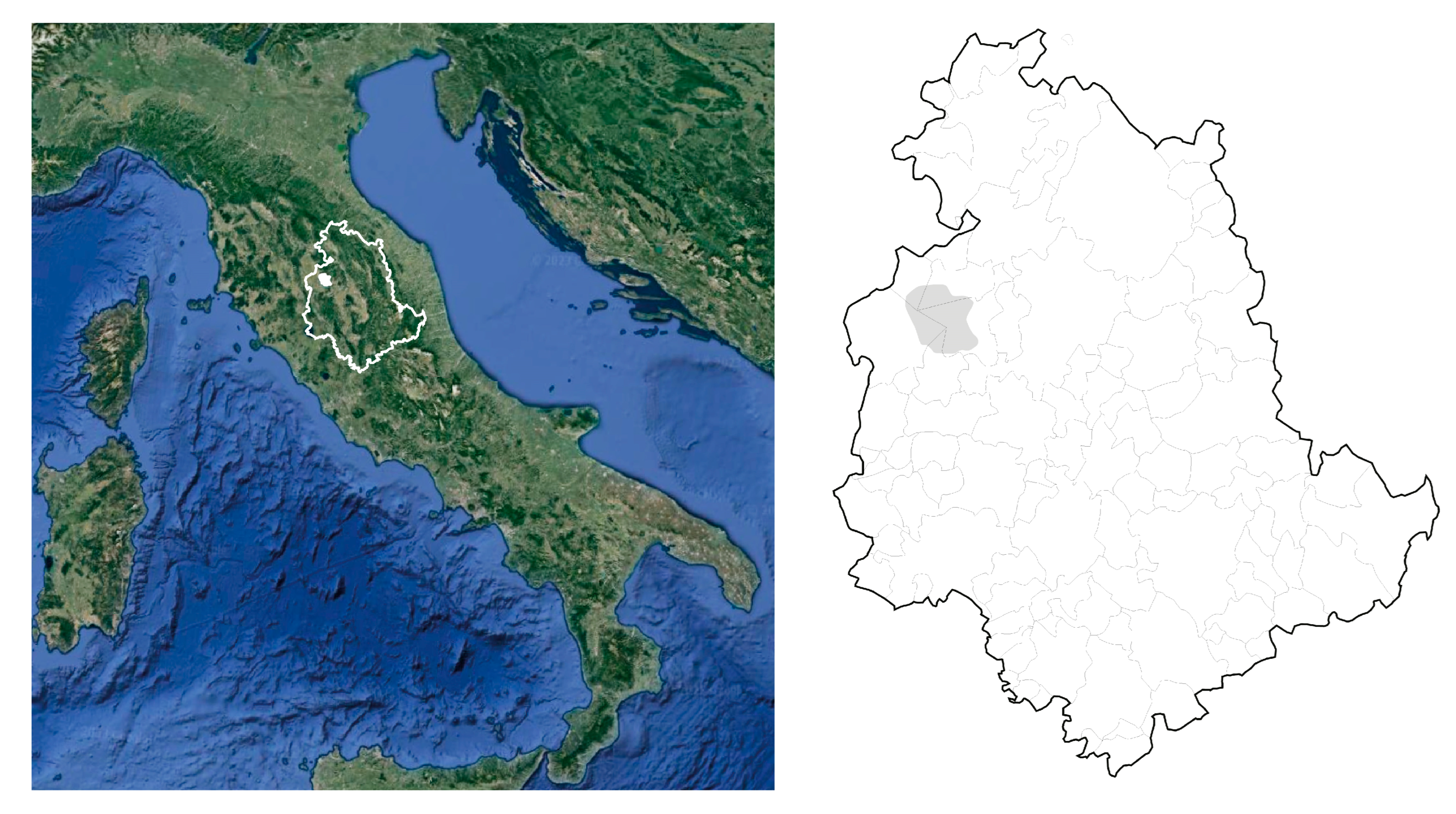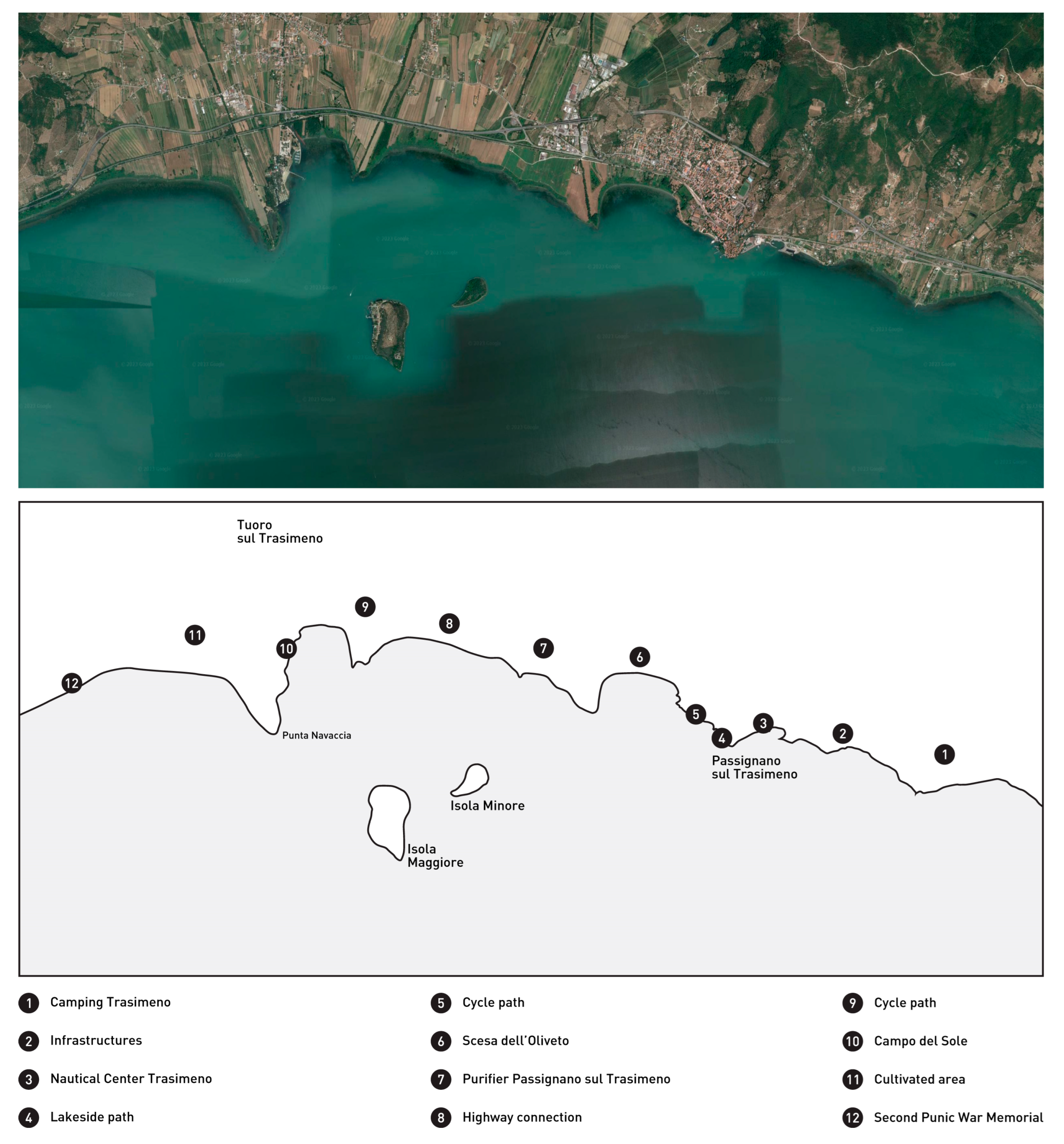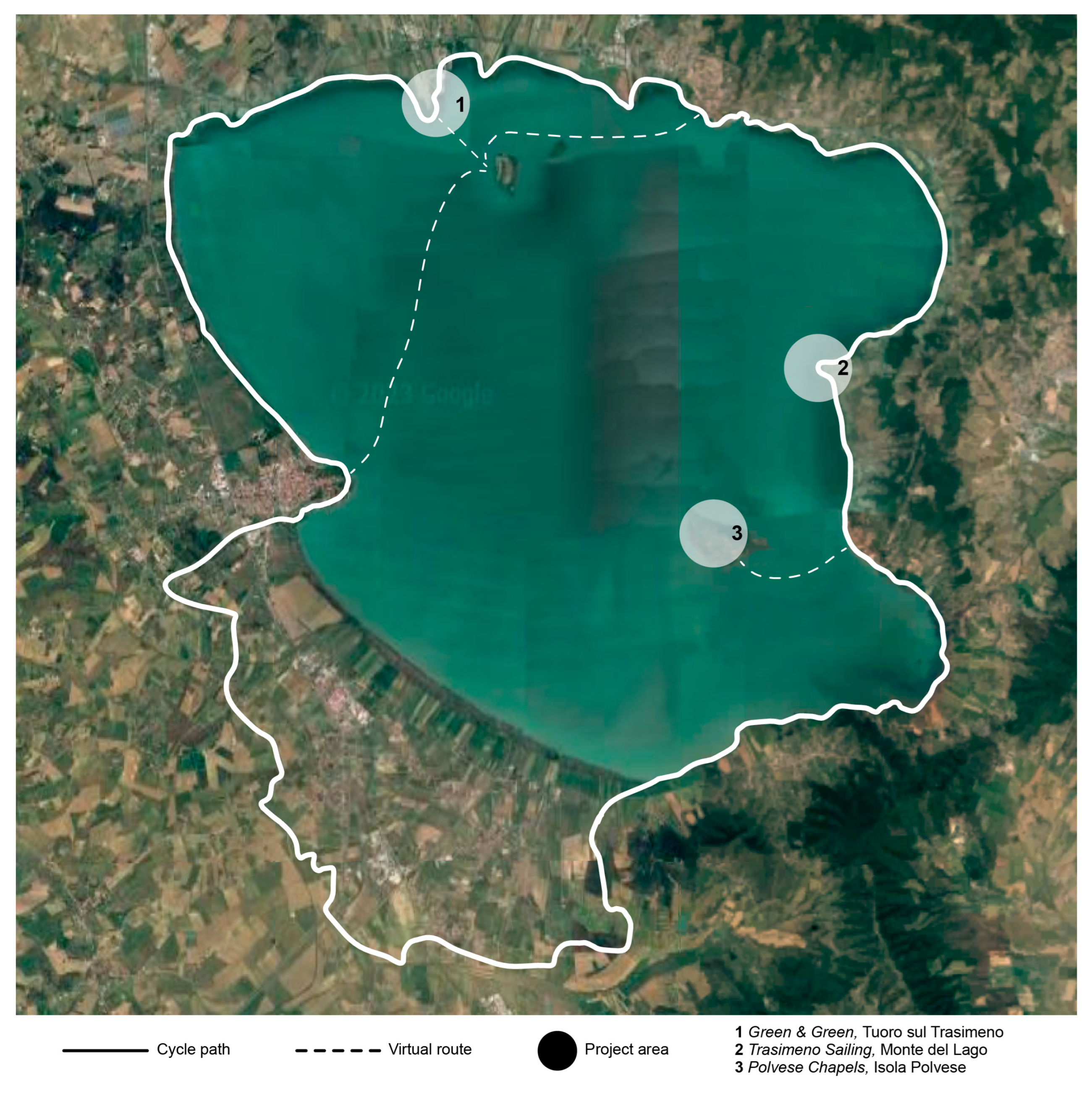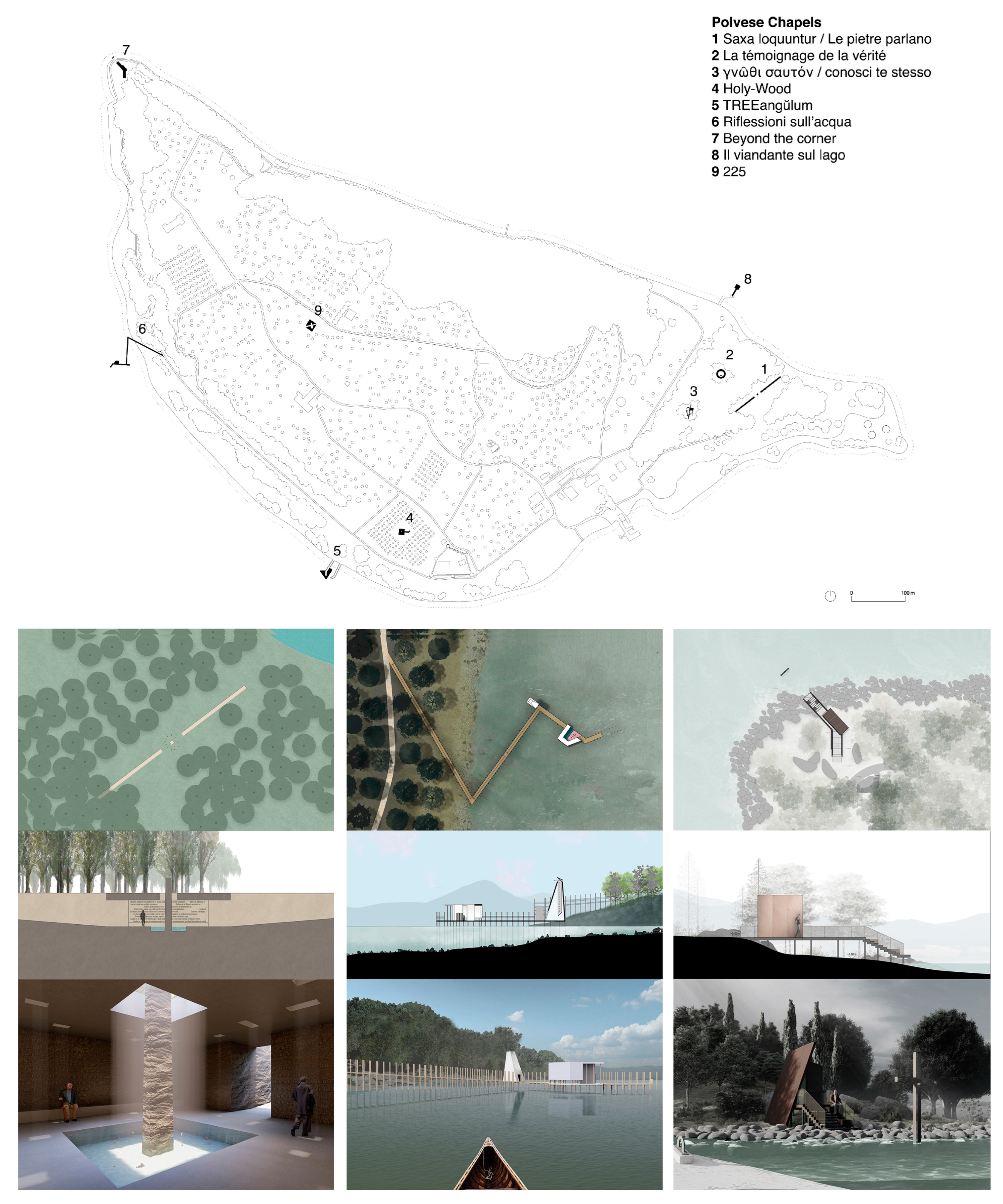Heritage Trasimeno: From Mapping the Dynamics of Landscape Transformation to Possible Strategies for Heritage Use
Abstract
:1. Introduction
2. Tourism in the Lake Trasimeno Area
3. Heritage Mapping/Interpretation
3.1. Mapping Methodology
- a.
- Ortophoto comparison
- b.
- Multisensory mapping
3.2. Mapping Results
4. Heritage Communication/Experience
5. Results and Conclusions
Author Contributions
Funding
Institutional Review Board Statement
Informed Consent Statement
Data Availability Statement
Acknowledgments
Conflicts of Interest
References
- Burzigotti, R.; Capuano, M.C. (Eds.) Zoom Sull’ambiente: L’Isola Polvese; Provincia di Perugia, Assessorato all’Ambiente Area Promozione Risorse Ambientali: Perugia, Italy, 2004. [Google Scholar]
- Longo, C.; Salerno, P. Isola Polvese: Itinerari tra Natura, Arte, Cultura; Plestina Società Cooperativa: Perugia, Italy, 2006. [Google Scholar]
- Nicoletti, M. Isola Polvese. Territorium egregium. Diomede Riv. Cult. Politica Dell’umbria 2006, 4, 43–50. [Google Scholar]
- Pisinicca, E. Vicende Storiche dell’Isola Polvese; Protagon Editrice: Perugia, Italy, 1991. [Google Scholar]
- Brandi, C. Umbria Vera; Edizioni Della Cometa: Roma, Italy, 1986. [Google Scholar]
- Montella, E. (Ed.) Perugia; Electa Editori Umbri: Perugia, Italy, 1993. [Google Scholar]
- Duranti, M. (Ed.) Gerardo Dottori, Opere 1898–1997; EFFE Fabrizio Fabbri Editore: Perugia, Italy, 1997. [Google Scholar]
- Flussi Turistici in Umbria Anno 2022. Available online: https://www.regione.umbria.it/turismo-attivita-sportive/statistiche-turismo-2022 (accessed on 20 July 2023).
- Strategia Aree Interne 2021–2027. Available online: https://www.regione.umbria.it/strategia-aree-interne-2021-2027 (accessed on 20 July 2023).
- PNRR Umbria 2021–2026. Piano Nazionale di Ripresa e Resilienza; Regione Umbria-Giunta Regionale: Perugia, Italy, 2021. [Google Scholar]
- Hall, M.; Zeppel, H. Cultural and heritage tourism: The new grand tour. Hist. Environ. 1990, 7, 86–98. [Google Scholar]
- Bruscino, A. Il Turismo Sostenibile; Libreriauniversitaria: Padova, Italy, 2021. [Google Scholar]
- United Nations. Report of the World Commission on Environment and Development: Our Common Future. 1987. Available online: https://www.unicas.it/media/2732719/Rapporto_Brundtland_1987.pdf (accessed on 20 July 2023).
- Clarke, J. A Framework of Approaches to Sustainable Tourism. J. Sustain. Tour. 1997, 5, 224–233. [Google Scholar] [CrossRef]
- Messina, S.; Santamato, V.R. (Eds.) Esperienze e Casi di Turismo Sostenibile; Franco Angeli: Milano, Italy, 2012. [Google Scholar]
- Contratto di Paesaggio del Trasimeno. Available online: https://www.regione.umbria.it/dettaglionotizie/-/asset_publisher/lU1Y2yh4H8pu/content/contratto-di-paesaggio-del-trasimeno-insediato-tavolo-di-lavoro-interistituzionale?read_more=true (accessed on 20 July 2023).
- Osservatorio Regionale per la Qualità del Paesaggio. Available online: http://www.umbriapaesaggio.regione.umbria.it/pagine/piano-paesaggistico-regionale-000 (accessed on 20 July 2023).
- Cosgrove, D. (Ed.) Mappings; Reaktion Books: London, UK, 1999. [Google Scholar]
- Cosgrove, D. Cultural cartography: Maps and mapping in cultural geography. Ann. Géographie 2008, 660–661, 159–178. [Google Scholar] [CrossRef]
- Ganciu, A. Geometric Modelling in the Narrative of Metropolitan Areas: A View on Attraction Dynamics. Diségno 2023, 12, 99–112. [Google Scholar] [CrossRef]
- Taylor, D.R.F. Maps and mapping in the information era. In Proceedings of the 18th International Cartographic Conference, Stockholm, Sweden, 23–27 June 1997. [Google Scholar]
- Taylor, D.R.F.; Caquard, S. Cybercartography: Maps and Mapping in the Information Era. Cartogr. Int. J. Geogr. Inf. Geovisualization 2006, 41, 1–6. [Google Scholar] [CrossRef]
- Diaconu, M. (Ed.) Senses and the City. An Interdisciplinary Approach to Urban Sensescapes; Lit: Vienna, Austria; Berlin, Germany, 2011. [Google Scholar]
- Moretti, F.R. La Multimedialità e il Futuro della Cartografia. Available online: https://www.treccani.it/enciclopedia/la-multimedialita-e-il-futuro-della-cartografia_%28XXI-Secolo%29/ (accessed on 20 July 2023).
- Cullen, G. Townscape; The Architectural Press: London, UK, 1961. [Google Scholar]
- Salerno, R. Mapping Urban Environment by Geometry(es) and Perception(s). In Urban Design and Representation; Piga, B., Salerno, R., Eds.; Springer: Cham, Switzerland, 2017. [Google Scholar] [CrossRef]
- Salerno, R. Digital Technologies for “Minor” Cultural Landscapes Knowledge: Sharing Values in Heritage and Tourism Perspec-tive. In Geospatial Intelligence: Concepts, Methodologies, Tools, and Applications; IGI Global: Hershey, PA, USA, 2019; pp. 1645–1670. [Google Scholar] [CrossRef]
- Debord, G. Theorie de la derive. Les Lèvres Nues 1956, 9, 6. [Google Scholar]
- O’Rourke, K. Psychogeography: A Purposeful Drift through the City. 2021. Available online: https://thereader.mitpress.mit.edu/psychogeography-a-purposeful-drift-through-the-city/ (accessed on 10 September 2023).
- Caquard, S.; Griffin, A. Mapping Emotional Cartography. Cartogr. Perspect. 2019, 91, 4–16. [Google Scholar] [CrossRef]
- Wartmann, F.M.; Koblet, O.; Purves, R.S. Assessing experienced tranquillity through natural language processing and landscape ecology measures. Landscape Ecol. 2021, 36, 2347–2365. [Google Scholar] [CrossRef] [PubMed]
- Nold, C. (Ed.) Emotional Cartography. Technologies of the Self. 2009. Available online: http://www.emotionalcartography.net/ (accessed on 20 July 2023).
- Correggiari, M.; Mappe emozionali. Interagire con la Percezione del Paesaggio, Master in World Natural Heritage Management. Available online: https://www.researchgate.net/publication/311807785_Mappe_emozionali_Interagire_con_la_percezione_del_paesaggio_Ricerca_e_idea_progettuale (accessed on 20 July 2023).
- Balestrieri, M.; Cicalò, E. Se la rappresentazione si autoavvera. Relazioni di co-evoluzione tra il territorio e la sua immagine. Territorio 2020, 93, 7–12. [Google Scholar]
- De Rubertis, R. La Riva Perduta. Piano di Monitoraggio e di Riqualificazione delle Fasce Costiere Italiane; Officina Edizioni: Roma, Italy, 2005. [Google Scholar]
- Misharina, A.; Betts, E. The Embodied City: A Method for Multisensory Mapping. In Capturing the Senses. Quantitative Methods in the Humanities and Social Sciences; Landeschi, G., Betts, E., Eds.; Springer: Cham, Switzerland, 2023. [Google Scholar] [CrossRef]
- Dal Co, F. (Ed.) Vatican Chapels; Electa: Milano, Italy, 2018. [Google Scholar]
- Berardi, D. Progetto di Ricomposizione Architettonica e Paesaggistixa dell’area di Punta Navaccia a Tuoro (PG). Master’s Thesis, Department of Civil and Environmental Engineering, University of Perugia, Perugia, Italy, 2019. [Google Scholar]
- Hoflab. Club Nautico. 2016. Available online: http://www.hoflab.it/architetture/regesto/club-nautico (accessed on 20 July 2023).
- Pink, S. Sensing Cittàslow: Slow living and the constitution of sensory city. Senses Soc. 2007, 2, 59–77. [Google Scholar] [CrossRef]
- Gemini, L. Viaggio. Immaginario, Comunicazione e Pratiche del Turismo Contemporaneo; Franco Angeli: Milano, Italy, 2008. [Google Scholar]








Disclaimer/Publisher’s Note: The statements, opinions and data contained in all publications are solely those of the individual author(s) and contributor(s) and not of MDPI and/or the editor(s). MDPI and/or the editor(s) disclaim responsibility for any injury to people or property resulting from any ideas, methods, instructions or products referred to in the content. |
© 2023 by the authors. Licensee MDPI, Basel, Switzerland. This article is an open access article distributed under the terms and conditions of the Creative Commons Attribution (CC BY) license (https://creativecommons.org/licenses/by/4.0/).
Share and Cite
Belardi, P.; Menchetelli, V.; Ramaccini, G. Heritage Trasimeno: From Mapping the Dynamics of Landscape Transformation to Possible Strategies for Heritage Use. Sustainability 2023, 15, 14777. https://doi.org/10.3390/su152014777
Belardi P, Menchetelli V, Ramaccini G. Heritage Trasimeno: From Mapping the Dynamics of Landscape Transformation to Possible Strategies for Heritage Use. Sustainability. 2023; 15(20):14777. https://doi.org/10.3390/su152014777
Chicago/Turabian StyleBelardi, Paolo, Valeria Menchetelli, and Giovanna Ramaccini. 2023. "Heritage Trasimeno: From Mapping the Dynamics of Landscape Transformation to Possible Strategies for Heritage Use" Sustainability 15, no. 20: 14777. https://doi.org/10.3390/su152014777
APA StyleBelardi, P., Menchetelli, V., & Ramaccini, G. (2023). Heritage Trasimeno: From Mapping the Dynamics of Landscape Transformation to Possible Strategies for Heritage Use. Sustainability, 15(20), 14777. https://doi.org/10.3390/su152014777







